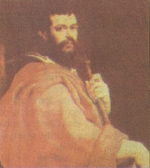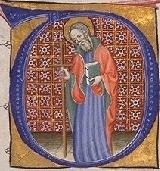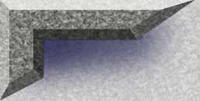|
(A Fourteenth Century Painting
of St. James by Simone Matine)
Patron Saint of: arthritis,
Chile, hatmakers, labourers, milliners, rheumatism

When our parish was founded in 1956 it was placed under the
patronage of St James the Greater, Apostle and close friend of Our Lord. (He is Called `The Greater' to distinguish
him from that other St James, Apostle and Bishop of Jerusalem, who is known as `The Lesser,' perhaps because he was younger
or smaller in stature than our patron) St. James the greater was one of those humble ones of the earth personally chosen
by Our Lord to assist Him in founding His Church. He and his brother John, were the sons of Secede and that
Mary Salome who was a near relative of our Blessed Lady. Natives of Bethsaida, the young men grew up to be fishermen
on the lake of Galilee, in partnership with the brothers Peter and Andrew. After the Miraculous Drought of the Fishes
`gave up all things' to follow Our Lord and to become, in the fullness of time, `Fishers of Men'. Their mother, Salome,
moreover, joined the company of those pious women who ministered to Our lord and his disciples during the public life. She
was to be found ever by Our lady's side thereafter, and especially in that darkest hour at the foot of the cross.

|
 |
|
The James whose shrine is at Santiago
de Compostela, in north-west Spain, was the brother of John (the Evangelist). The Gospels (Matthew 4, 21-22; Mark 1, 19-20;
Luke 5, 10-11) record that they were fishermen, the sons of Zebedee, and were called by Jesus from mending their nets beside
the sea of Galilee at the beginning of His ministry. He nicknamed them 'the sons of thunder' (Mark 3,17). James was present
at some of the key events in Jesus's life (e.g. the Transfiguration: Matthew 17, 1-13; Luke 9, 28-36), but the only certain
fact recorded of him afterwards is his martyrdom at the hands of Herod Agrippa in 44 A.D. (Acts 12, 1-2).
Legend has it that when the Apostles
divided the known world into missionary zones, the Iberian peninsula fell to James. 7th and 8th century documents (i.e. prior
to the discovery of the tomb) refer to the belief that he spent a number of years preaching in Spain before returning to Jerusalem,
and martyrdom. His followers are believed to have carried his body down to the coast and put it into a stone boat, which was
carried by angels and the wind beyond the Pillars of Hercules (the straits of Gibraltar), to land near Finisterre, at Padrón,
on the Atlantic coast of northern Spain. He was buried a little way inland, and the site of his tomb was forgotten for some
800 years.
Early in the 9th century a hermit,
Pelayo, was led by a vision to the spot. The tomb was rediscovered, and the relics authenticated as those of St James by the
local bishop. Spain at this period sorely needed a new champion or focus to inspire Christians against the invading Moors.
The rediscovery came therefore at a most propitious moment. And the pilgrimage began ...
|
 |
|
|
 |
|
|
|

